The aim of this glossary is to introduce in a simple and comprehensive way the most common issues and solutions of stucco systems. A picture is worth a thousand words, so our glossary provides images of different completed projects and troubleshooting issues.
We were trying to use layman’s terms and simple descriptions for our customer’s benefits. We hope to deliver sufficient answers to commonly asked questions and appreciate you visiting. For free estimates, call 404 593 7273.
Bird Holes
EIFS systems are an easy target for bird and rodent destruction. A thin coat of basecoat and finish doesn’t represent a sufficient durable barrier for bird picks. The problem turns even more troublesome, considering the fact that the areas of damage are often far off the ground and birds being very teritorial will come back multiple times to cause damages in the same spot. SsiS provides following types of services:
– bird holes repairs
– affected area resurfacing reinforcement (permanent solution)
– affected area system replacement (permanent solution)

Bird holes on the corner quoin.

Bird hole – chimney (LP siding).

Inadequate sealant – bird holes filled up with expanding spray foam.
Bulges
There are multiple reasons for a stucco system malfunction known as bulging. Bulging happens when a system fails to adhere due to fastners, adhesive (glue) failure, or expansion joints malfunctions. There may be multiple reasons for exterior envelope buckling. The most common reasons are:
Settlement or contraction of the wall frame
– In residential construction, the wooden frame may settle after a certain period of time, causing extra stucco to buckle.
– Commercially used steel frames may contract under changing temperatures. To avoid those types of situations expansion and control joints are being installed.
Air pressure (strong wind)
Pressure differential caused by blowing wind may be the reason of fasteners or adhesive failure, that creates a bulge on the surface. This type of bulging is a common characteristic to EIFS systems, and to estates located on hills and in wind ridges.
Moisture Damages
Substrat and frame affected by moisture intrusion may let the fasteners loose and cause adhesive to delaminate. In some cases an EIFS system may be applied on drywall, as it’s substrate is attached with cement adhesive. Moisture intrusion will rapidly affect the paper coating and cause area to get loose and buckle.
Fasteners or adhesive failure
Application of adhesive in freezing temperatures or use of bottle caps as fasteners may cause the future stucco system to buckle.
Solution – To repair a bulging area, buckling sections should be removed and reinstalled. Expansion and control joints are applied where necessary. In most cases of bulging wall repairs, large sections need to be resurfaced to keep wall visibly uniform. SsiS provides repair services for bulging, cracking and loose stucco.
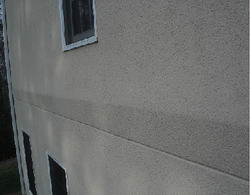
Settlement bulge over expansion joint on the EIFS system. Second story frame settled causing insulation board to fold out coat

Settlement bulges on the hard coat system caused by contractions of the metal frame.

Loose sheets of insulation board on an EIFS system. The visible shape of 2′ x 4′ rectangles suggest fasteners or adhesive failure.
Chimney Cap
SsiS provides the following services:
– chimney cap replacement
– flashing extensions
– chimney cap & stucco junction sealant

A proper chimney cap should overlap top of the stucco trim

Wood frame even with chimney cap edge. Space between the stucco and the wood may still be subjected to moisture intrusion by wind driven rain or capillary suction.
Solution: The junction should be cleaned, primed and sealed with use of low modulus sealant.
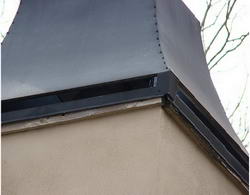
Wood frame exposed under chimney cap. This area maybe subject to moisture intrusion.
Solution:
– Replace or alter the chimney cap or
– Install a strip of flashing as an extension under the overlapping cap edge.
Cracks
Cracks appear due to damaging system surface tensions, caused by settlement or frame and backing contractions. SsiS provides services in the area of crack repair.

Wrinkle crack – effect of vertical frame settlement.
Solution: Size of loose section needs to be determined. If affected is only surface coat and rest of the area seem to be attached and sound delamination should be removed, smoothed and patched
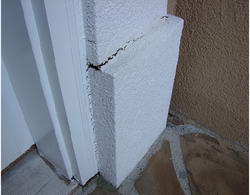
Settlement crack – Stone step visible below pulled down while settling door side trim
Solution: Crack should be patched with use of base coat , fiber mesh and finish coat. Settlement, though may be still in progress and crack may re-appear in order to avoid repetition of following malfunction. Bottom of the trim should be terminated on stone venire level and proper sealants applied.

Massive settlement bulges and cracks. In case of such a broad malfunction no low budget solution may be available if the wall is divided by expansion and control joints only the affected section may be addressed. Generally whole subject area needs to be removed and replaced
Cricket Flashing
SsiS provides repairs of cricket flashing malfunctions:
– Flashing replacement
– Exterior flashing aplication covered with stucco trim or metal strip
– Roof line termination to expose flashing.

Top junction of cricket flashing – inadequate application

Top junction of cricket flashing – proper application

Exterior flashing – application without roof shingles or stucco removal.Vertical section of the flashing may be covered with stucco trim or exterior flashing.
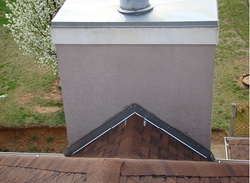
Exterior flashing covered
Delamination
SsiS provides all types of repairs of delaminating or weathering damaged stucco surfaces.
For free estimates call 404 593 7273
Delamination of stucco is an adhesive faliure of one of the weather barrier layers. For example, a silicone sealant may pull the finish coat off the base coat surface, or high temperatures will separate the basecoat and insulation board.
Remember! Keep your grill and other high heat sources away from your EIFS walls.
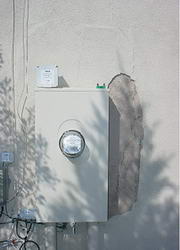
Delamination of surface coat (hard coat).
Solution:
All loose layer should be removed and exposed surface covered with fiber reinforced coat and finish coat.

Delamination of finish and basecoat of EIFS surface caused by weathering. Visible exposed fiber mesh.
Solution:
The Affected area needs to be resurfaced (mesh reinforced base coat and finish).

Surface weather damage.
Diverter – Corner Flashing
SsiS provides following types of services:
– corner diverter installations
– roofline flashing replacement
– exterior roofline flashing installation
For free estimates call 404 593 7273

Corner diverter flashing on the bottom of the chimney. Picture taken during installation.
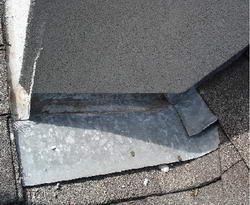
Corner diverter and flashing junction. Picture taken while stucco being cut on roofline termination.
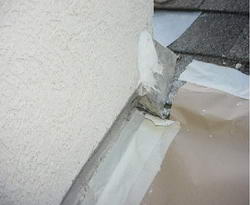
Corner diverter flashing on the top of the chimney

Corner diverter flashing doubled by exterior flashing
Drip Cap Flashing
SsiS provides following types of services:
– drip cap installations
– drip cap replacement
For free estimates call 404 593 7273


Missing drip cap.
Top of garage door frame exposed and missing protection of drip cap. Moisture trapped on the horizontal surface may damage garage door frame hether, and wall frame.
Solution:
Proper drip cap needs to be installed.

Drip cap malfunction.
Space between drip cap & window frame may be source of moisture intrusion caused by wind driven rain or even capilary suction.
Solution:
Exposed spaces need to be sealed.
EIFS
EIFS – non load bearing exterior cladding system. aka „thin coat”

1. Insulation board
2. Fastener (mechanical attachment)
3. Glass fiber reinforcing mesh embedded in base coat Base Coat (1/16” to 3/32” or thicker) Adhesive mixed with portland cement
4. Finish coat over base coat
5. Adhesive : glue or base coat
6. Concrete slab
7. Wood frame
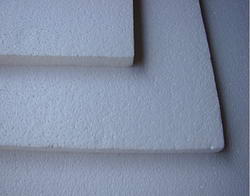
Expanded Polstyrene (EPS) insulation board. The most common insulation board in residential construction is made out of omnipresent styrofoam. White, 1 inch thick, 2 feet by 4 feet sheets are commonly used.
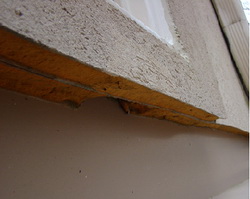
Quik-R insulation board – polyisocyanurate foam Surface of Quik-R boards are coated with compressed fibers. This insulation board is light in weight and meets most residential energy codes. There is no need to use mesh and backer boards.
Common malpractice of neglecting mesh application on top of decorative window trim, key stones, quoince, resulting with damages on those flat accents. Without mesh reinforcement on the edge, Quik-R board is vulnerable to impact damages and weather erosion.

Reinforcement fiber mesh
Expansion Joints
SsiS provides following types of services:
– expansion and control joint installation (hard coat)
– expansion joint installation (EIFS)
For free estimates call 404 593 7273
The function of an expansion joint is to divide a large size area in order to avoid cracking caused by surface tension. A real expansion joint is a „built in” detail that aims to divide larger areas into smaller sections. Sections should not exceed 144sq ft.. Build in expansion joints are characteristic to hard coat & hybrid systems. EIFS systems may be divided by ¾ inch backwrapped space filled with backer rods and sealed with low modulus sealant. In most cases, EIFS walls are divided on the floor joyce level by aesthetical grooves.
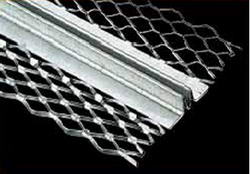
Iron galvanized expansion joint

Expansion and control joints – hard coat system
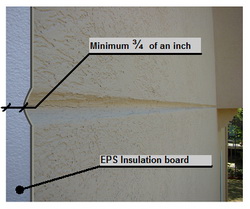
Aesthetic groove dividing floor levels on EIFS cladding. The depth of the groove should not leave less than 3/4” at the base of joint.
Frieze Board
SsiS provides services of:
– frieze board and side board sealing
– replacement of frieze board, soffit and facial boards
For free estimates call 404 593 7273

Frieze board is generally a flat board where a stucco system terminates horizontally under the roof soffit. The space between friezeboard and the wall should be sealed with proper sealant, even small separation maybe subject of capillary suction or intrusions due to wind driven rain.

Large space between frieze board and stucco cladding – use of closed cell backer rod necessary.
Side board is a flat board where the stucco system terminates vertically.

Space between soffit and stucco should be sealed with proper low modulus sealant.
Grade Termination
SsiS provides fallowing types of services:
– grade cut termination (EIFS)
– grade cut termination (hard coat)
– decorative trim or stone veneer application
For free estimates call 404 593 7273
Stucco systems terminating below grade level exposes a house to both pest and moisture intrusion. Insulation board should be cut at a 45 degree angle 3” to 8” above the grade level. The cut junction should be sealed with a fiber reinforced base coat and acrylic finish.


Quick-R type insulation board below grade behind driveway. Bottom of EIFS was cut but never sealed, removing this piece will leave 1 inch space between driveway and concrete slab.

Termite damages under removed EIFS on the grade level.

Basecoat breaking off – cementous coating applied without reinforcement mesh and finish – adhesive failure.

After removal of thick foam detail remaining space between driveway and garage slab should be filled up with concrete mix (satisfactory color match hard to obtain) or some type of cover (stone venir or hard coat trim) should be applied after proper grade sealing.

Stone veneer covering an EIFS system termination after proper grade sealing.

Durock board screwed on exposed bottom of wall framing while terminating EIFS 7′ above ground level. Durock is a cementous fiber reinforced board.
Hard Coat
SsiS provides following types of services:
– Hard Coat system repairs
– New Hard Coat system installation
For free estimates call 404 593 7273
A Hard Coat system is also known as hard stucco or European stucco. It consist of three separate coats applied on vapor barrier (black paper) and reinforced by diamond lath (galvanized metal net). First two coats – scratch coat, and brown coat are made of mixed sand, portland cement and lime. It’s sometimes reinforced by synthetic fibers. To avoid surface cracks separate coats need to cure between applications. The third – finish coat in most cases the is the same acrylic based product as the one used in EIFS or hybrid systems. In average 3/8 – ½ inch Cementitious coat creates a durable impact resistant exterior envelope.



Scratch coat.

Brown coat.

Finish coat.
Impact Damages
EIFS system may be easily damaged under impact trauma. Baseball, golf balls, landscaping equipment, pressure washers and hail will cause all kind of dings, holes and cuts. To reinforce the walls, heavy duty impact mesh may be applied (heavy traffic areas, walls in a golf balls range).
SsiS provides following types of services:
– Impact damages and openings repair
– Area resurfacing reinforcement (golf ball damages)
– Affected area system replacement (permanent solution)
For free estimates call 404 593 7273

Damage on the garage trim – One of the most common areas of impact damage.

Golf ball damages – In most of the cases only a certain section of the house will be affected.

Kickout Flashing
Kickout flashing may be the most important water flow diverting detail in stucco & siding exterior envelopes. Missing kickout or one with a malfunction may cause extensive damages to substrat, wood frame, wall insulation and even the house interior.
SsiS provides following types of services:
– kickout flashing installations
– kickout flashing re-instalations
– repair of damages caused by missing or unperforming kickouts.

Molded PVC kickout diverter.

Missing kickout

How to make kickout out of regular roof line flashing.

How to make kickout out of regular roof line flashing.

How to make kickout out of regular roof line flashing.

How to make kickout out of regular roof line flashing.
Kickout Malfunction

Kickout inadequate – flashing was cut to be bent no sealant present in the corner. Possible water intrusion in cut junction.

Kickout flashing malfunction – rusted through.

Inadequate Kickout – installed over the roofline, the flashing is too far up from the gutter junction. Water can still intrude under the flashing.

Inadequate Kickout – deflecting a water current may overflow resulting in intrusion.
Kickout damages
Damages caused by missing or failing kickout flashing are probably the most common flashing related issue on both EIFS and hard coat systems. As all moisture intrusion related devastation, progress may continue visually undetected for years. In most cases interior evidence may not present either. The only way to determine if the intrusion is occuring is by utilizing moisture detection devices. Moisture trapped in the stucco system is not only a wood frame damage factor, its a perfect enviroment for mold and fungus. In some cases termites and ants attracted by constant access of moisture will escalate size of damage and time of it’s progress.
SsiS provides all types of repairs related to missing or dysfunctional kickouts, call 404 593 7273


Damages on the facial board & soffit may be an indication of continous water intrusion due to missing kickout or it’s malfunction.

Damages under missing kickout flashing – PB EPS foam. Visible termite activity.

Extended damages to the side and bottom of the chimney due to a kickout flashing malfunction

Damages under missing kickout flashing (chimney) – PB quick-R foam Original wooden siding exterior of the house covered with EIFS system.
Patch Job
It’s not an easy task to create a perfectly blended patch on the stucco surface. Colors of every section of the house will change over the years. Sections exposed to sun will fade away while the north side may get darkened by mold. In some cases to keep the wall uniform, an entire section of the wall needs to be resurfaced. Besides the color dilemma, the texture pattern must be followed to create a succesfully blended patch.
SsiS provides following types of services:
– holes and impact damages repair
– area resurfacing and painting
For free estimates call 404 593 7273

Two patches on the chimney. The large patch below is much less visible than small yellow one.

Patch made with inadequate filler. Painted over with wall color but no texture

Inadequate patch – wrong type of base coat mix caused delamination

Inadequate patch – Wrong filler, color match and application
Roofline Termination
SsiS provides the following types of services:
– roofline termination
– roofline flashing replacement
For free estimates call 404 593 7273

2” termination above shingles – flashing being exposed to see its condition.

Rusted roofline flashing has to be completely removed.

Roofline flashing replacement.
Rotted Wood (Doors and Windows)
Window and door malfunctions may be the cause of dramatic damages to a stucco system. A deteriorating window or door wood frame allows moisture to stay trapped and in effect causes damage to the substrate, wall frame and cladding system below. Poor quality windows may turn the life of a stucco home owner into a nightmare. Temporary touch up repairs (bondo, wood putty) rarely improve the situation as a long time solution. In many cases, window replacement is a better option than repairing multiple rotted components
SsiS provides the following types of services:
– Rotted wood replacement
– Window / door replacement
– Sash repairs
For free estimates call 404 593 7273

Nose sill, inner sill and brick molding rotted This size of gap may be indication of moisture entrapment behind stucco system.

In some cases window replacement is the only option. Damages to the window sill exposes all of the wall frame below.

Substrate and frame damages caused by dysfunctional window.

Rotted door threshold. Damages previously covered up with wood putty.
Sealants
The most common sealants for stucco systems are silicone and polyurethane based. Silicones are resistant to weathering and ultraviolet light. Their high flexibility and adhesion give them a life expectancy greater than 20 years.
For waterproofing services, SsiS uses and recommends Dow Corning 790 and 795.

The most common moisture entry points on the house. Exterior envelope systems can be through or around the windows, doors, and all wall penetrations. Proper sealant should be applied on every transition of wall cladding and dissimilar material.

Moisture damages under the window related to missing sealant.

Right color match and even, smooth bid makes all of the difference. Unfortunately most of the sealants come in a limited number of colors, so a perfect match is not always possible. Painting silicone sealants requires the use of adequate primers. Regular latex paint will not successfully cover their surface.

High adhesion is an expected quality of sealants. In the same respect once applied silicone is hard to remove and leftover marks may be visible.

Missing sealant – AC lines.

Missing sealant – patio door.

Adhesive faliure Loss of bond of the sealant.

Cohesive faliure. Tear or split of sealant within itself. Changing temperatures may impair movement capability of sealant. Polyurethane based sealants tend to stiffen, their lost flexibility affects cohesive faliure.

Sealant deterioration. Exposure to ultra-violet light may damage the surface of some polyurethane sealants. Their organic base tends to deteriorate in the presence UV rays. Polyurethane sealants have a 5 – 10 year life expectancy, while silicone is 20 years and over.
Stains on Stucco
Stains if organic based (mold, algae) are easy to remove with a chlorine solution or pressure washing. Remember, a high PSI pressure washer may easily cut an EIFS surface. Mineral oxidation stains (rust), UV light color fading, or air pollution discolorations are harder to remove, and tend to reappear.
SsiS provides the following services in order to remove stains:
Painting, cleaning, pressure washing and resurfacing entire affected areas.
For free estimates call 404 593 7273

Mold stains – Easy to remove by pressure washing and a chlorine solution.

Mildew stains

Stucco discoloration – Color fading due to chemical reactions Repainting should be a long term solution.

Oxidation stains – Minerals flashing through resulting in rusty dots This wall was painted once before, however, the rust keeps reappearing. A permanent solution is to resurface the affected area with a new layer of base coat and finish coat.

Corner bead, rust flashing through – This type of stain is charasteristic to a hard coat system. Metal trim accessories used in this type of cladding, even though galvanized, may flash with rusty stains if the protective surface was scratched during application.

Chimney cap rust stains Getting rid of stains by painting the chimney must be followed by chimney cap replacement or cleaning, priming and painting it with proper paint. Faliure to do following will cause stain to reappear shortly.

Air polution stains – house in close proximity to major highway.
Stucco Textures
Finish coat is the aestethical face of the house and is an important part of a weather barrier.

“Worm holes”, “Quartzputz”, “Natural Swirl” or “Perfect”.

“Sandblast”, “Limestone” or “Spray”

“Free style”
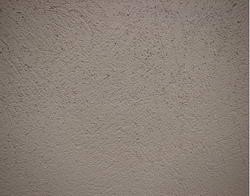
Flat hard coat finish, primed and painted.
Substrate
There are different types of frame sheathing allowed for EIFS system applications. In residential construction: plywood, OSB board, plaster board (drywall) are the most common types of backer board.

Left side: Polimer modified extruded foam used as substrat for Quick-R type EIFS system. Right side: OSB (compressed wood) board as a backing.

Drywall – gypsum paper faced board as a substrat for PB EIFS system.

Siding covered with Quick-R foam.
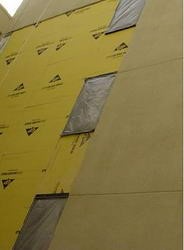
Dens Glass Gold – gypsum glass mat faced, mostly commercial use.
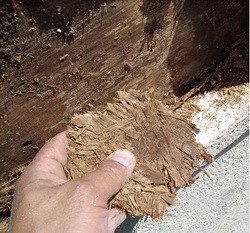
OSB board damaged by moisture.



